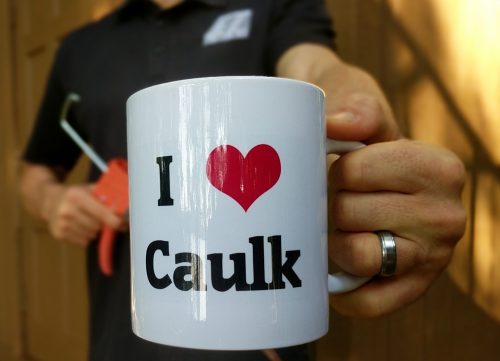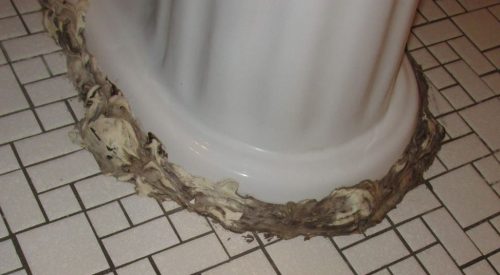Toilets are a divisive topic, but today I’ll set the record straight once and for all on three important toilet topics. First, the toilet paper roll: overhand or underhand? There’s only one right answer, of course, and it’s overhand. There’s no point in even discussing this one.
Toilet seat: up or down? Wrong question! It’s not about the seat. It’s about the lid. The lid is there for a reason. Put it down. Ladies, you’re guilty of this too. I’ve been in countless female-only homes where I found the lid up at every toilet. I document every one of them in my toilet lid journal.
And now, onto the most divisive topic. Unlike the first two, this one is real, and it actually gets a fair amount of discussion. Should toilets be caulked at the floor? The answer is yes.
Toilets should be caulked at the floor
As standard procedure for every home inspection that I perform, I check the toilets to make sure they’re properly anchored to the floor. Almost every time I find a loose toilet, I also find missing caulk at the base of the toilet. The two go hand-in-hand.
When I find a loose toilet, I tell my client to secure the toilet to the floor properly and to caulk around the base, but I frequently get clients who tell me they’ve heard otherwise.
The thought process behind not caulking a toilet to the floor is that if the toilet leaks at the floor, you’ll quickly find out about the leak as long as the toilet isn’t caulked. If it is caulked, the thinking is that if the toilet flange leaks, you’ll end up trapping water between the toilet base and the floor in an area that you can’t access.
In reality, toilets rarely leak onto the floor. More often, they leak through the floor around the flange. I’ve found plenty of toilets that leak down into the basement, but very few that leak onto the bathroom floor.
Why caulked?
There are two great reasons to caulk a toilet to the floor:
1. Caulk prevents a fouling area. If mop water, bathtub water, or a less pleasant “bathroom liquid” gets underneath the toilet, there is no way to clean it up. Caulking around the base of the toilet will prevent this from happening.
2. Caulk helps to keep the toilet secured to the floor. The bolts are supposed to keep the toilet secure, but caulk helps. As I mentioned before, toilets that are caulked at the floor are rarely loose. Caulk does such a good job of keeping toilets secured to the floor that you could probably rely on caulk alone to keep a toilet secured… not that I would try this.
Besides these two great reasons, it’s also a code requirement. The Minnesota State Plumbing Code says, under section 402.2, “Where a fixture comes in contact with the wall or floor, the joint between the fixture and the wall or floor shall be made watertight.” For areas of the country where the IRC has been adopted, you’ll find nearly identical language under section P2705.1.3: “Where fixtures come in contact with walls and floors, the contact area shall be water tight.”
Some people prefer to caulk all around the toilet and leave about a one-inch gap in the caulk at the back of the toilet to allow water to escape in the event of a leak. It’s already tough enough to caulk behind a toilet, so if this is what you want to do, God bless. Just don’t go crazy with the caulk.



Dan
August 1, 2017, 7:28 am
Reuben,
Great topic, and for us timely.
But 1st, the paper off the roll, over or under, I’m an under guy.
Over has less “friction” and the roll spins too long. It’s like the spool on a bait caster, there has to be a little friction to prevent bird’s nests.
As for the argument about getting the wall dirty, for you have that problem, you have bigger problems . 🙂
Now to the caulk, I agree that fixtures should be caulked, but that’s not the question, the question is when, how and with what.
And I don’t have the answers to these questions.
I can say that bedding the fixture “may” result in loose bolts as the materiel relaxes under load/time, causing a leak.
Can you shed any light on this?
Reuben Saltzman
August 1, 2017, 8:46 am
Hi Dan,
I’m no authority on the execution of caulking a toilet at the floor. I’ve probably installed about a dozen toilets, and I’ve always used silicone at the base after the toilet has been installed. If someone has a recommendation for a better product or method, I’d be open to hearing it.
Emilie Quast
August 1, 2017, 2:12 pm
One correction: TP: overhand or underhand. It depends on the cat in the house and also if you really like the pattern printed on the TP you bought. If your cat likes making the TP spin, you probably want the free end closest to the wall, so the critter can just claw against the roll and it stays rolled. If your cat isn’t too interested in that toy, you have options. Enjoy them.
Lids: Also depends on the dog or cat’s favorite source of hydration. I will say that having a pet who insists on only the freshest water is good incentive for keeping the WC fresh and clean, because, euwwww.
I’ll leave the “real” topics to you, Reuben.
Reuben Saltzman
August 1, 2017, 2:19 pm
Emilie – solid arguments. I stand corrected.
Alex
August 6, 2017, 8:01 am
Hi Reuben,
Now to address the controversy regarding:
to caulk, or to grout…
Dan
August 7, 2017, 10:16 pm
Thanks Reuben,
Yes, that’s what I have done recently. I have an older install that the toilet didn’t sit square on the floor, and started rocking after a few years, resulting in a leak.
Dan
Frank
September 20, 2023, 5:24 am
floors are never perfectly flat and often the area where the bowl is secured has a bump that causes the toilet to rock and break the ring; so I would level the area first by some means before replaceing a new ring, if not it would only break again.
Frank ODonnell
September 20, 2023, 5:29 am
PS I always did believe in caulking around the toilet bowl, but then I heard that the code doesn’t allow it, so I am glad to learn that it is finally settled that caulking is the right way to go.